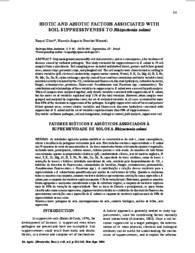Biotic and abiotic factors associated with soil supressiveness to Rhizoctonia solani.
Biotic and abiotic factors associated with soil supressiveness to Rhizoctonia solani.
Author(s): GHINI, R.; MORANDI, M. A. B.
Summary: Crop management may modify soil characteristics, and as a consequence, alter incidence of diseases caused by soilborne pathogens. This study evaluated the suppressiveness to R. solani in 59 soil samples from a microbasin. Soil sampling areas included undisturbed forest, pasture and fallow ground areas, annual crops, perennial crops, and ploughed soil. The soil samples were characterized according to abiotic variables (pH; electrical conductivity; organic matter content; N total; P; K; Ca; Mg; Al; H; S; Na; Fe; Mn; Cu; Zn; B; cation exchange capacity; sum of bases and base saturation) and biotic variables (total microbial activity evaluated by the CO2 evolution and fluorescein diacetate hydrolysis; culturable bacterial, fungal, actinomycetes, protozoa, fluorescent Pseudomonas and Fusarium spp. communities). The contribution and relationships of these variables to suppression to R. solani were assessed by path analysis. When all samples were analyzed together, only abiotic variables correlated with suppression of R. solani, but the entire set of variables explained only 51% of the total variation. However, when samples were grouped and analyzed by vegetation cover, the set of evaluated variables in all cases accounted for more than 90% of the variation in suppression of the pathogen. In highly suppressive soils of forest and pasture/ fallow ground areas, several abiotic variables and fluorescein diacetate hydrolysis correlated with suppression of R. solani and the set of variables explained more than 98% of suppressiveness.
Publication year: 2006
Types of publication: Journal article
Unit: Embrapa Environment
Observation
Some of Embrapa's publications are published as ePub files. To read them, use or download one of the following free software options to your computer or mobile device. Android: Google Play Books; IOS: iBooks; Windows and Linux: Calibre.
Access other publications
Access the Agricultural Research Database (BDPA) to consult Embrapa's full library collection and records.
Visit Embrapa Bookstore to purchase books and other publications sold by Embrapa.

